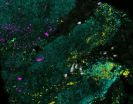(Press-News.org) Oil reservoirs are scattered deep inside the Earth like far-flung islands in the ocean, so their inhabitants might be expected to be very different, but a new study led by Dartmouth College and University of Oslo researchers shows these underground microbes are social creatures that have exchanged genes for eons.
The study, which was led by researchers at Dartmouth College and the University of Oslo, appears in the ISME Journal. A PDF is available on request.
The findings shed new light on the "deep biosphere," or the vast subterranean realm whose single-celled residents are estimated to be roughly equal in number and diversity to all the microbes inhabiting the surface's land, water and air. Deep microbial research may also help scientists to better understand life's early evolution on Earth and aid the search for life on Mars and other planets.
Some scientists support a "burial and isolation" scenario in which bacteria living in oil reservoirs are descendants of isolated bacterial communities buried with sediments that over time became oil reservoirs. "Instead, our analysis supports a more complex 'colonization' view, where bacteria from subsurface and marine populations have been continuously migrating into the oil reservoirs and influencing their genetic composition since ancient times," says co-author Olga Zhaxybayeva, an assistant professor at Dartmouth.
Since the 1980s, a growing number of microbial life forms have been discovered deep underground, but many questions remain, including when and how these microorganisms came to inhabit places where temperatures and pressure are extreme and nutrients and energy can be scarce. Microorganisms are the oldest form of life on Earth and continue to play a crucial role in the planet's ecosystem. Those bacteria dwelling underground live not off sunlight energy but the Earth's inner heat, chemicals and nutrients.
In their new paper, researchers asked a number of questions, including: do buried bacteria adapt to living in oil reservoirs as they form from sediments? Do bacteria evolve in isolation, or do they migrate to oil reservoirs and exchange genes with surrounding bacteria, including surface ones introduced through drilling fluids used in oil production? The researchers analyzed 11 genomes of Thermotoga, an ancient lineage of heat-loving bacteria, taken from oil reservoirs in the North Sea and Japan and from hot water vents on the ocean floor near the Kuril Islands north of Japan, Italy and the Azores, an island chain west of Portugal. They also analyzed Thermotoga community DNA from the environment (so-called metagenomes) from North America and Australia that are available in public databases.
The results reveal extensive gene flow across all the sampled environments, suggesting the bacteria do not stay isolated in the oil reservoirs but instead have long migrated to and colonized the reservoirs and contributed to their genetic make-up. "The pathway of the gene flow remains to be explained, but we hypothesize that a lot of the gene flow may happen within the subsurface," says co-author Camilla Nesbø, a researcher at Centre for Ecological and Evolutionary Synthesis at the University of Oslo. Zhaxybayeva and Nesbø's previous research showed that Thermotoga and its close relatives have exchanged small pieces of genome with Archaea, an ancient single-celled life form different from bacteria, and with another distant group of bacteria, Firmicutes.
INFORMATION:
The study was funded by the Norwegian Research Council and conducted by researchers at Dartmouth, the University of Oslo, University of Alberta, Yale University, University of Connecticut, University of Bergen and Russian Academy of Sciences.
Available to comment are co-authors Olga Zhaxybayeva at Olga.Zhaxybayeva@dartmouth.edu and Camilla Nesbø at c.l.nesbo@bio.uio.no.
Broadcast studios: Dartmouth has TV and radio studios available for interviews. For more information, visit: http://www.dartmouth.edu/~opa/radio-tv-studios/
BOZEMAN, Mont. - Cathy Cripps doesn't seem to worry about the grizzly bears and black bears that watch her work, but she is concerned about the ghosts and skeletons she encounters.
The ghosts are whitebark pine forests that have been devastated by mountain pine beetles and white pine blister rust, said the Montana State University scientist who studies fungi that grow in extreme environments. The skeletons are dead trees that no longer shade snow or produce pine cones. The round purple pine cones hold the seeds that feed bears, red squirrels and Clark's nutcracker birds. ...
Amsterdam, NL, December 12, 2014 - A patient who had suffered a traumatic brain injury unexpectedly recovered full consciousness after the administration of midazolam, a mild depressant drug of the GABA A agonists family. This resulted in the first recorded case of an "awakening" from a minimally-conscious state (MCS) using this therapy. Although similar awakenings have been reported using other drugs, this dramatic result was unanticipated. It is reported in Restorative Neurology and Neuroscience.
Traumatic brain injuries occur at high rates all over the world, estimated ...
New Rochelle, NY, December 11, 2014--In cases of traumatic brain injury (TBI), predicting the likelihood of a cranial lesion and determining the need for head computed tomography (CT) can be aided by measuring markers of bone injury in the blood. The results of a new study comparing the usefulness of two biomarkers released into the blood following a TBI are presented in Journal of Neurotrauma, a peer-reviewed journal from Mary Ann Liebert, Inc., publishers. The article is available free on the Journal of Neurotrauma website at http://online.liebertpub.com/doi/full/10.1089/neu.2013.3245 ...
Training older people in the use of social media improves cognitive capacity, increases a sense of self-competence and could have a beneficial overall impact on mental health and well-being, according to a landmark study carried out in the UK.
A two-year project funded by the European Union and led by the University of Exeter in partnership with Somerset Care Ltd and Torbay & Southern Devon Health and Care NHS Trust gave a group of vulnerable older adults a specially-designed computer, broadband connection and training in how to use them.
Those who received training ...
WOODS HOLE, Mass.--Since the first "catalog" of the normal bacterial makeup of the human body was published in 2012, numerous connections between illness and disturbances in the human microbiota have been found. This week, scientists report yet another: Cancerous tumors in the ascending colon (the part nearest to the small intestine) are characterized by biofilms, which are dense clumps of bacterial cells encased in a self-produced matrix.
"This is the first time that biofilms have been shown to be associated with colon cancer, to our knowledge," says co-author Jessica ...
PITTSBURGH--An interest in the gender gap between the representations of female candidates in U.S. elections compared to their male counterparts led two University of Pittsburgh professors to take the issue into the laboratory for three years of research.
Associate Professors of Political Science Kristin Kanthak and Jonathan Woon have published an article about the first phase of their research findings. "Women Don't Run? Election Aversion and Candidate Entry" was published online Dec. 2 in the American Journal of Political Science.
"Past research has shown that women ...
A group of researchers from Recep Tayyip Erdoğan University, Faculty of Fisheries in Turkey discovered a new trout species. The newly described species Salmo kottelati, belongs to the Salmonidae family, which includes salmons, trouts, chars, graylings and freshwater whitefishes.
Salmonids include over 200 species, which have a high economic value because of their taste and famed sporting qualities.
The genus Salmo is widely distributed in rivers and streams of basins of the Marmara, Black, Aegean and Mediterranean seas. The genus is represented by 12 species in ...
In a contribution to an extraordinary international scientific collaboration the University of Sydney found that genomic 'fossils' of past viral infections are up to thirteen times less common in birds than mammals.
"We found that only found only five viral families have left a footprint in the bird genome (genetic material) during evolution. Our study therefore suggests that birds are either less susceptible to viral invasions or purge them more effectively than mammals," said Professor Edward Holmes, from the University of Sydney's Charles Perkins Centre, School of ...
A new study analyses the violent behaviours exhibited towards pregnant women. While 21% of women suffer emotional violence during pregnancy, 3.6% encounter physical or sexual violence. Furthermore, 36.1% of those who reported physical violence claimed that it happened "very often" or "daily".
Whilst for many women pregnancy is a happy time, for almost one in four it turns out not to be so enjoyable. An investigation into the prevalence of domestic violence against pregnant women has found that 22.7% endure some kind of violence - emotional, physical or sexual - within ...
For the first time researchers have measured large distances in the Universe using data, rather than calculations related to general relativity.
A research team from Imperial College London and the University of Barcelona has used data from astronomical surveys to measure a standard distance that is central to our understanding of the expansion of the universe.
Previously the size of this 'standard ruler' has only been predicted from theoretical models that rely on general relativity to explain gravity at large scales. The new study is the first to measure it using ...



